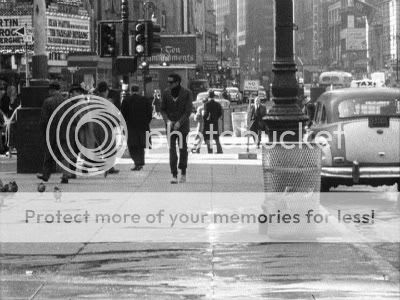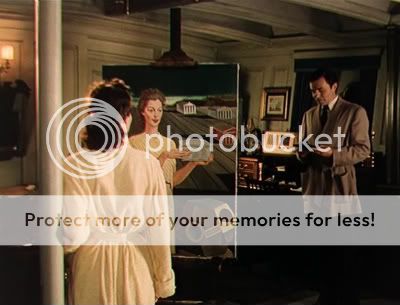6/28/11 LE BICHES (Claude Chabrol, 1968)
6/28/11 LE BOUCHER (Claude Chabrol, 1970)
6/27/11 FULL METAL JACKET (Stanley Kubrick, 1987)
6/25/11 BAD DAY AT BLACK ROCK (John Sturges, 1955)
6/25/11 DIRTY HARRY (Don Siegel, 1971)
6/23/11 HARRY POTTER AND THE DEATHLY HALLOWS PT. 1 (David Yates, 2010)
6/20/11 CHLOE IN THE AFTERNOON (Eric Rohmer, 1972)
6/19/11 ADVISE & CONSENT (Otto Preminger, 1962)
6/18/11 NOTRE MUSIQUE (Jean-Luc Godard, 2004)
6/18/11 BODY DOUBLE (Brian De Palma, 1984)
6/17/11 HIGH AND LOW (Akira Kurosawa, 1963)
6/16/11 BADLANDS (Terrence Malick, 1973)
6/16/11 IMITATION OF LIFE (Douglas Sirk, 1959)
6/14/11 THE ACT OF SEEING WITH ONE'S OWN EYES (Stan Brakhage, 1962)
6/14/11 DOG STAR MAN (Stan Brakhage, 1962)
6/14/11 WEDLOCK HOUSE: AN INTERCOURSE (Stan Brakhage, 1959)
6/14/11 DESISTFILM (Stan Brakhage, 1955)*
6/12/11 EVEN DWARFS STARTED SMALL (Werner Herzog, 1970)
6/11/11 THE GENERAL (Buster Keaton, 1927)
6/11/11 MIDNIGHT IN PARIS (Woody Allen, 2011)
6/11/11 THE TREE OF LIFE (Terrence Malick, 2011)
6/11/11 BLOW OUT (Brian De Palma, 1989)
6/10/11 THE LADIES MAN (Jerry Lewis, 1961)
6/8/11 SCARLET STREET (Fritz Lang, 1945)
6/4/11 GENTLEMEN PREFER BLONDES (Howard Hawks, 1953)*
6/2/11 THE SOFT SKIN (François Truffaut, 1964)
6/2/11 SHADES OF FERN (Frantisek Vlácil, 1984)
*rewatch
Diary of a Country Cinephile
Thursday, June 30, 2011
Saturday, June 11, 2011
BLOW OUT (Brian De Palma, 1981)
 Previous De Palma's Seen: PHANTOM OF THE PARADISE, OBSESSION, SCARFACE
Previous De Palma's Seen: PHANTOM OF THE PARADISE, OBSESSION, SCARFACEBLOW OUT is a conspiracy thriller in the direct tradition of REAR WINDOW and THE CONVERSATION. Antonioni's BLOW-UP is an obvious citation, but De Palma's film, while harboring some semblance of cultural critique, is far less indebted to the European art-house than to bold, extravagant American genre cinema. From the gratuitous murders (one of which is so superfluous in its sadism that it lowers the film in my estimation) to the red-white-and-blue color patterning to the jarring camera movements, De Palma communicates loudly in broad visual strokes. His protagonist (John Travolta) used to wire undercover cops before a grisly accident befell the department's best officer, and he is now a sound designer for a low-budget video production company specializing in cheap exploitation films. Witness to a car accident that leads to the death of a political candidate and having recorded what appears to be a gun shot, Travolta finds a way out of the tedium of his low-rent job and back into the thrills that characterized his police-work. If his obsessive quest to revitalize his numbing existence by embarking on a murder-uncovering quest is reminiscent of James Stewart in REAR WINDOW, then the bitter lack of closure and ultimate tragedy of THE CONVERSATION defines the haunting conclusion, in which the pieces never really fall together and an emotional tragedy surmounts the resolution of the mystery. De Palma, as he did when he re-appropriated VERTIGO in OBSESSION, places the themes of REAR WINDOW in a new context. Just as the incapacitated Stewart enlisted love interest Grace Kelly in his exploits to expose the murderer, so too does Travolta send out Nancy Allen to do his dirty work as he listens from a distance. Stewart found his brand of artistic fulfillment in his own backyard, but Travolta overreaches to the tragic misfortune of his lover. And yet Travolta does achieve a form of artistic fulfillment, injecting the auditory remains of the tragic affair into the Z-grade slasher flick he derided at the film's beginning. You could say that this final image of an awe-struck Travolta mesmerized by the final outcome corresponds to De Palma himself, an artist who finds art where camp and sublimity intersect.
Sunday, April 10, 2011
WHERE THE SIDEWALK ENDS | Otto Preminger | 1950
 This is a noir that hits me in the same way that The Big Heat hits me. it has a surface layer of film noir tropes and moods that immediately wins it over to me. The photography is dark and gloomy, the taxicabs stop right in front of the camera lens, that parking garage goes on forever, those big-city backdrops fill the eyes with luminous wonder. The title is immediately gripping, especially when matched to the illustrative opening credits. From the get-go you can tell you're in for a good noir in every superficial way that matters, and when it comes to this genre, those are often the aspects that I take most seriously.
This is a noir that hits me in the same way that The Big Heat hits me. it has a surface layer of film noir tropes and moods that immediately wins it over to me. The photography is dark and gloomy, the taxicabs stop right in front of the camera lens, that parking garage goes on forever, those big-city backdrops fill the eyes with luminous wonder. The title is immediately gripping, especially when matched to the illustrative opening credits. From the get-go you can tell you're in for a good noir in every superficial way that matters, and when it comes to this genre, those are often the aspects that I take most seriously.But there's so much more going on here. Dana Andrews is a notoriously tough cop with daddy issues, out to prove that he's the reverse of his criminal father by relentlessly going after Scalise, a mob boss the old man had helped set up. But we only get this information after Andrews has accidentally killed a suspect by knocking him out, fracturing the steel-plated skull the man had obtained during the war. From this point onward, it's impossible to see the man as a hero, and Preminger tackles the issue of whether there really is a line between 'cop and killer,' the phrase that Scalise uses in the film's harrowing climax. This isn't simply an internal morality play; the lieutenant played by Karl Malden seems equally despicable in his eagerness to close the case by pinning the murder on Gene Tierney's affable father, and while Scalise is responsible for the murder of a gambling associate, there is otherwise nothing tangible outside of his snarling charisma that gives us grounds to judge him. This latter point makes Andrews' resolution to pin him for the murder he himself committed particularly damning.
The moment that Andrews does murder the suspect is an important one. Unlike in Anatomy of a Murder, another Preminger film in which the consequences of a single act of violence proliferate out and color multiple people who elude definitive moral judgment, the murder is definitively depicted, and all queries about it afterward hold little mystery for us. However, the dramatic irony and the suspense it generates are often unbearable, and it is never possible to know how things will end up. I can't think of a similar Hollywood film in which the protagonist is so clearly doomed from the start, and not because of any external or cosmic force, but because of his own fault. Preminger treats the event with such moral seriousness, that you know that there will be no Hollywood loopholes that allow everyone to get out unscathed, and so the remainder of the film had me transfixed on the screen, probing Andrews' character for damning or redemptive traits that would help guide me to some sort of opinion on how I hoped the story would end up. To the very end, not only could I not expect what would happen, but I could not determine what I wanted to happen either.
After the murder, Preminger spends his time establishing a web of characters who have been affected by Andrews in some way. Tierney's father idolizes him; it turns out the friendly old cab driver assisted him in a case several years back. The man is endearing but overzealous in his love for his daughter and a spinner of exaggerated yarns. Andrews looks down on him for his enthusiasm and blatant fabrications, but when the man is booked for the murder, it is Andrews and not the cabbie who is withholding the truth. The owner of a shoddy restaurant who recalls Thelma Ritter's character from Pickup on South Street has a playfully antagonistic relationship to Andrews, who sent her husband away for wife-beating. In fact, everyone who resorts to unnecessary violence ends up getting punished, either by the law or by the mob, and Andrews is no exception.
And finally, moral ambiguity seeps out of every crevice of the story. Does Andrews feel genuine remorse for killing the suspect, or is it simply a feeling of distaste for acting so much like the father he has a deep-seated hatred for? Is his valiant assault on Scalise, conducted as a self-sacrificial means of extricating Tierney's father, not also a cowardly and irrational way for him to settle all of his psychological issues? The ending, in which he finally confesses, even after everything has been settled, is a moment of moral transformation. His motive for doing so can no longer be linked to the demons the story has propped up to complicate our attitude towards him, and Tierney's assurance that she will give him all the chances in the world is so lovely it makes me want to cry.
Saturday, April 9, 2011
Exploring Cassavetes: FACES
 Faces is probably my least favorite of the four Cassavetes films I've seen, but if Shadows has taught me anything, it's that a re-watch will probably increase my appreciation substantially. For Ray Carney, however, Faces is possibly Cassavetes' grand achievement and the ultimate distillation of his philosophy of selfhood as a process of interaction and even more potent than Shadows because of the force of its anguish and devastation. In Carney's analysis of Faces, he repeats his past mistakes of exaggerating his dichotomous view of cinema and illustrating how Cassavetes is an immensely more complicated and humanistic filmmaker than the likes of Welles and Hitchcock. Outside of a few explications of quoted dialogue, Carney rarely examines specifics and instead prefers to reiterate his grand thesis ad infinitum, albeit each time with a different modification of language. Ultimately, it feels as if you have spent pages reading the same thing, that the characters can only discover themselves in relation to the people they interact with, and that the downside of self-mutability is the danger of codifying one's performance into a stultifying formula.
Faces is probably my least favorite of the four Cassavetes films I've seen, but if Shadows has taught me anything, it's that a re-watch will probably increase my appreciation substantially. For Ray Carney, however, Faces is possibly Cassavetes' grand achievement and the ultimate distillation of his philosophy of selfhood as a process of interaction and even more potent than Shadows because of the force of its anguish and devastation. In Carney's analysis of Faces, he repeats his past mistakes of exaggerating his dichotomous view of cinema and illustrating how Cassavetes is an immensely more complicated and humanistic filmmaker than the likes of Welles and Hitchcock. Outside of a few explications of quoted dialogue, Carney rarely examines specifics and instead prefers to reiterate his grand thesis ad infinitum, albeit each time with a different modification of language. Ultimately, it feels as if you have spent pages reading the same thing, that the characters can only discover themselves in relation to the people they interact with, and that the downside of self-mutability is the danger of codifying one's performance into a stultifying formula.Again, this is not to say that Carney does not have valuable things to say about Faces, but it seems as if he hopes to convince us more of his and Cassavetes' philosophy of life than the genius of his cinema. It is true that the more he writes about this perspective on human interaction, the more the film becomes clarified, but it would also be helpful if the film received more direct analysis. The most fascinating things he discusses are Cassavetes' refusal to condescend to 'lesser' characters, and his withholding of moral judgment of his characters, a key trait that removes him from the vast majority of Hollywood cinema. Also helpful for me is why he views Chet and Jeannie (Seymour Cassel and Gena Rowlands) as characters who have found out how to survive in Cassavetes' universe and are able to react to other people without attempting to dominate.
For me personally, the film lacked the slipshod, idiosyncratic endearment of Shadows, nor does it drive the theme of marital collapse as far as A Woman Under the Influence does. However, this is not to criticize it, as it only seems lesser to me in comparison to Cassavetes' other films. It remains a visceral, furious masterpiece that may be the ideal point of entry into Cassavetes' work. Its frenetic camera, band of performers, themes of collapse and self-annihilation, and rapid-fire conversations are certainly part of a whole, and each of these things exists in the rest of his work to some extent. And yet, aside from The Killing of a Chinese Bookie, it's the only film of his that I have seen that didn't quite move me to the point of tears. But it is exhausting, engaging, overwhelming in its power, bleak in its view of human relationships, and, seen in the right frame of mind, potentially earth-shattering.
Friday, April 1, 2011
Viewing Log: 3/1/11 - 3/31/11
3/30/11 GOOD MORNING | Yasujirô Ozu | 1959
3/29/11 PANDORA AND THE FLYING DUTCHMAN | Albert Lewin | 1951
3/29/11 FACES | John Cassavetes | 1968
3/26/11 CERTIFIED COPY | Abbas Kiarostami | 2010
3/25/11 THE DARJEELING LIMITED | Wes Anderson | 2007
3/23/11 TRUST | Hal Hartley | 1990
3/19/11 UNCLE BOONMEE WHO CAN RECALL HIS PAST LIVES | Apichatpong Weerasethakul | 2010
3/18/11 SISTERS OF THE GION | Kenji Mizoguchi | 1936
3/14/11 SECONDS | John Frankenheimer | 1966
3/6/11 KELLY'S HEROES | Brian G. Hutton | 1970
3/5/11 THE KING'S SPEECH | Tom Hooper | 2010
3/5/11 EARTH | Aleksandr Dovzhenko | 1930
3/4/11 FREAKS | Tod Browning | 1932
3/3/11 MACBETH | Roman Polanski | 1971
3/29/11 PANDORA AND THE FLYING DUTCHMAN | Albert Lewin | 1951
3/29/11 FACES | John Cassavetes | 1968
3/26/11 CERTIFIED COPY | Abbas Kiarostami | 2010
3/25/11 THE DARJEELING LIMITED | Wes Anderson | 2007
3/23/11 TRUST | Hal Hartley | 1990
3/19/11 UNCLE BOONMEE WHO CAN RECALL HIS PAST LIVES | Apichatpong Weerasethakul | 2010
3/18/11 SISTERS OF THE GION | Kenji Mizoguchi | 1936
3/14/11 SECONDS | John Frankenheimer | 1966
3/6/11 KELLY'S HEROES | Brian G. Hutton | 1970
3/5/11 THE KING'S SPEECH | Tom Hooper | 2010
3/5/11 EARTH | Aleksandr Dovzhenko | 1930
3/4/11 FREAKS | Tod Browning | 1932
3/3/11 MACBETH | Roman Polanski | 1971
Wednesday, March 30, 2011
Sunday, March 27, 2011
CERTIFIED COPY | Abbas Kiarostami | 2010
 Certified Copy is quite possibly the most enrapturing movie I have ever seen. It is simultaneously intellectual and deeply emotional, and unlike the more cerebral, high-concept manifestation of the puzzle film, Certified Copy is less about any abstract jigsaw than about the more fascinating puzzle of human behavior as it exists in finite space and time, eschewing the notion of overarching philosophy for something deeper, more mysterious, and ultimately extremely moving. No matter how you look at it you wind up with a Pandora's Box of emotional and thought-provoking consequences.
Certified Copy is quite possibly the most enrapturing movie I have ever seen. It is simultaneously intellectual and deeply emotional, and unlike the more cerebral, high-concept manifestation of the puzzle film, Certified Copy is less about any abstract jigsaw than about the more fascinating puzzle of human behavior as it exists in finite space and time, eschewing the notion of overarching philosophy for something deeper, more mysterious, and ultimately extremely moving. No matter how you look at it you wind up with a Pandora's Box of emotional and thought-provoking consequences. If the couple is not a married couple then the film is about exploring the shared lives people can create without knowing each other, how their simulation of a marriage is a direct approach to an aesthetic argument of simulation and replication in art. If the couple is married, then the film is about a long-married couple attempting to recapture the springtime of their marriage both by simulating their honeymoon and by replicating themselves as they were fifteen years ago, creating copies of past lives that no longer correspond to their current selves. Or perhaps the time frames are shifting, the question of whether they are married or not can't even begin to be answered, and the couple transforms by some mysterious pirouette from new acquaintances into a married couple. But if this is the case, of course, then the continuity of their day-long dialogue becomes a surprisingly streamlined thread between two disparate time frames, so that the film is at once continuous and discontinuous. Even if you wish to forgo any such interpretation, you are still left with many hallmarks of Kiarostami's Iranian cinema (a restrictive camera that refuses to show us essential information lying outside the frame, pairing of professional and non-professional performers, various methods of implicating the audience in the narrative, etc.) and countless other points of entry (such as recurring visual motifs, the emotional rawness of the performances, references and allusions to the European art film of the past, etc.).
But what primarily matters is the feeling of existing with these people in a bounded temporality, replete with ravishing visual textures and moments of pure cinematic beauty. Kiarostami not only exercises his uncanny ability to depict the changes in visual atmosphere that transpire over the course of a day, but he also synchronizes these changes to the characters' constantly shifting emotional climate. Most of the intellectual ideas of the film, as I have so rudimentarily outlined them above, take form later, after mulling the film over in your mind (believe me, I have far from exhausted all options or meanings; in fact, the more I think about the film, the more convinced I am that the possibilities are endless), but its human and emotional truths unfold moment to moment within the film itself, and once it is over it is almost impossible to recapture them.
In other words, I believe Certified Copy has surmounted Playtime as my favorite film.
Friday, March 25, 2011
Exploring Cassavetes: SHADOWS
 When I first watched John Cassavetes' Shadows about a year ago, I rightfully wrote that it was spontaneous, ahead-of-its-time, awkward, and unpolished. However, I also wrongfully compared it to Altman, Allen, and Scorsese, none of whom even begin to match what Cassavetes is doing in his debut film. Like in Altman films, the dialogue overlaps, but unlike in Altman films, the overlap is not calculated as being part of a style or aesthetic, and it serves a function of directing your attention to multiple things at once (think the dance hall scene early on in the film). Altman still maps his scenes with clear focal points, the surrounding noise intended to locate his main attractions in 'true-to-life' situations. I compared Cassavetes' Manhattan to Allen's, again a gross miscalculation. Allen's New York is cultured and upscale, populated by neurotic intellectuals with easily pinpointed psychological issues. There is no place in Allen's filmography for grime or poverty or ramshackle apartments. Shadows depicts a more subterranean New York, one of bad nightclubs and damp courtyards and overcrowded streets. Scorsese may offer the best point of comparison, if only because Cassavetes exerts a more clear influence on him than the other two, and yet Scorsese's vulgar naturalism serves a far more holistic and deterministic function than Cassavetes', which is always employed as a means of penetrating his unclassifiable and unpredictable characters.
When I first watched John Cassavetes' Shadows about a year ago, I rightfully wrote that it was spontaneous, ahead-of-its-time, awkward, and unpolished. However, I also wrongfully compared it to Altman, Allen, and Scorsese, none of whom even begin to match what Cassavetes is doing in his debut film. Like in Altman films, the dialogue overlaps, but unlike in Altman films, the overlap is not calculated as being part of a style or aesthetic, and it serves a function of directing your attention to multiple things at once (think the dance hall scene early on in the film). Altman still maps his scenes with clear focal points, the surrounding noise intended to locate his main attractions in 'true-to-life' situations. I compared Cassavetes' Manhattan to Allen's, again a gross miscalculation. Allen's New York is cultured and upscale, populated by neurotic intellectuals with easily pinpointed psychological issues. There is no place in Allen's filmography for grime or poverty or ramshackle apartments. Shadows depicts a more subterranean New York, one of bad nightclubs and damp courtyards and overcrowded streets. Scorsese may offer the best point of comparison, if only because Cassavetes exerts a more clear influence on him than the other two, and yet Scorsese's vulgar naturalism serves a far more holistic and deterministic function than Cassavetes', which is always employed as a means of penetrating his unclassifiable and unpredictable characters.On viewing Shadows a second time I realized that I cared far less about its aesthetic merits than I did the first time: the telephoto street views, the jazz solos, and overall 'look' of the film meant far less to me than did the strength of the performances. When before I admired the film for being open-ended, now I realize that there is no real narrative that makes such a clarification necessary. The entire film is loose, freeform, devoid of linearity or purpose, and all that exists is undefined and undefinable characters undergoing crises of self that are beyond heartbreaking. When before I felt compelled to judge Tony for his racism, which causes him to reject Lelia and propels her into emotional hardness, I now found myself feeling his confusion, disillusionment and awkwardness in the face of what is undoubtedly a striking revelation, that Lelia is, in spite of her appearance, not white. I viewed him as another character in the ensemble rather than as an intruder or negative supporting player. Likewise, I found more to understand in the rest of the characters and their complicated performances. Overall, I felt an accumulation of raw experience that excited and stimulated me, and the prior conception I had of it as a loose, jazzy, independent experiment fell apart entirely. A Woman Under the Influence and The Killing of a Chinese Bookie have taught me that forming conceptions of Cassavetes films is fruitless work.
Supplementing my viewing were the first sections of Ray Carney's book-length study of Cassavetes' films. Carney's devotion to Cassavetes is so passionate and exclusive that he finds himself unable to care for the rest of American cinema, which he consigns to an unwavering style that emphasizes fixed characters and transparent 'deep meanings.' Whereas most Hollywood films tell the audience what to think and how to feel, set tones and moods and emotional cues, and strive for legibility at all costs, Cassavetes' films are about shifting surfaces and frenetic behavior, plotlessness and unpredictability. This dichotomy between two schools of cinema is unfortunately and self-evidently simplistic. Carney refers to Welles and Hitchcock over and over again. He claims this is because their films are the most viewed examples that illustrate his argument, but this leads to further difficulties. First, the reader gets the impression that Carney's understanding of Hollywood cinema is confined to a mere handful of canonized classics and well-publicized names. Carney is at pains to tell us that all of Hollywood operates on certain precepts, but fails to go outside his few meager examples. Even more grating is his insistence that both Welles and Hitchcock subscribe to this directorial philosophy, when he only seems to focus on Citizen Kane and Hitchcock's 50s period. Given that Welles's style changed drastically after traveling to Europe, Carney appears to be committing the cardinal sin of consigning the director to his most overpraised masterwork.
Thankfully, this polemic ends when he begins to write about Shadows, but while he has many important things to say about the film, he ends up returning to the same endless contrasts. Carney perpetually finds it necessary to prop up the rest of 'Hollywood cinema' as a negative image to illuminate Cassavetes' genius, and these comparisons prove tiresome. Even more repetitious is his inexhaustible arsenal of metaphors and explanations that emphasize the chasm between the self and its external representation, the clumsiness of his characters as they attempt to perform and express themselves, the ongoing process of revision and improvisation as the characters adjust and readjust to new events and surroundings, and various other iterations of what is essentially the same thing: the characters in Shadows have no fixed identity and are always changing. There comes a point where the reader wishes that Carney would write more about the specifics of the film, as opposed to Cassavetes' overarching philosophy and how this philosophy is so breathtaking and unique.
This is not to say that Carney does not provide many valuable insights. He is perhaps too attached to Cassavetes for these insights not to come across as veiled adulations, but his knowledge of Cassavetes is certainly comprehensive and incontestable. I am hoping that his analysis of Faces, a film he seems to regard even more highly than Shadows, fares better.
Tuesday, March 22, 2011
Placing Movies: The Practice of Film Criticism (Rosenbaum)

As the film critic whose work is most readily accessible to me, thanks to the work he has put into making most of his writings available online, Jonathan Rosenbaum has become a remarkable influence on the way I view cinema. Part of his achievement, and part of what makes him so appealing to me, is in his aim of disentangling film as an art form from film as an industry. As but one of many examples of this polemic that shaped the way I look at film criticism, many of the attitudes that I had once unconsciously formed on the matter of canonicity in cinema, a subject broached in the other book of his I have read, Essential Cinema, were instantaneously debunked upon reading his searing indictment of the American Film Institute's Top 100 Greatest Films list in conjunction with his lengthy and thoughtful reevaluations of many so-called classics that had piqued my curiosity. This skeptical and politically conscious attitude made Ebert's Great Movie essays, pieces that often equate 'greatness' with fame and influence as opposed to thoughtfulness and aesthetics and that were once my model of ideal film writing, all but obsolete.
Of course Rosenbaum's effect on me has been far greater than merely shattering my simplistic perceptions of institutionally fostered concepts of 'greatness' and classicality. In addition to guiding my tastes toward relatively unknown directors, both domestic and abroad, and instilling within me a skeptical predisposition toward the powers that be (whether obvious emblems of corruption such as Hollywood big whigs or less obvious targets such as myth-making biographers and unknowledgeable academics), Rosenbaum has served as a wellspring of all kinds of artistic discourse in addition to a guidepost to other brilliant critics and specialized texts. His often heated and occasionally acerbic writing is offset by his honesty, his lack of conformity and his willingness to share personal and autobiographical information in order to situate his arguments subjectively and place himself on speaking terms, as it were, with the reader. Placing Movies, in covering a larger span of his career and in providing five separate introductory pieces to the different sections of his book, contains more confessions, offhand references to personal struggles, and first-hand accounts of correspondence with critics, directors and other professionals than do the cumulative pieces I have read selectively from his website and the total output of Essential Cinema.
Almost all possible objections are directed toward his selection and categorization of pieces under separate headings, which are structured in a way that turns his introductory pieces into a sequential narrative thread. Because most of the book is a provocation in itself and very little of the writing avoids being combative in some way, a section entitled 'Provocations' seems redundant, and some pieces could have easily been swapped. For instance, a piece on Welles's Othello included in 'Touchstones' is lacking in the way of critical analysis on the film itself and is instead a highly informative investigation into the film's recent restoration. Perhaps, then, the piece could have functioned better as a 'Provocation' (especially considering that it begins with a blunt attack on the tendency of Corporate America to exploit the deceased Welles for its own ends) than as a 'Touchstone.' Some of the denser essays have the quality of over-analysis, and when two or more are placed consecutively with no shorter reviews to act as buffer, one gets bogged down and starts to notice how frequently Rosenbaum repeats certain terminology and lines of argument.
However, these criticisms are minor when viewed in conjunction with the sheer breadth of critical discourse provided. Whereas Essential Cinema is mostly Chicago Reader columns, Placing Movies includes work from all across the span of Rosenbaum's career, not all of it aimed at evaluating films exclusively. Rosenbaum includes much of his writing on other critics, from Manny Farber to Roland Barthes, and one searing piece towards the end of the book takes on an entire disposition of political complacency that Rosenbaum argues has dominated in our view of the history of the cinema, and the Blacklist era in Hollywood in particular. Some of his reviews are expedient and trenchant, for example his Soho News piece on Raiders of the Lost Ark that packs in a plenitude of references, analogies and anecdotes in the brief space it occupies, and others are immense undertakings that take a more serious and research-oriented approach toward their subjects, such as the immense article on Raoul Ruiz that seeks incredibly to synopsize his prolific oeuvre and predominant directorial philosophy, even as Rosenbaum finds himself without access to much of his work. Some Reader pieces I had read before, for instance the analyses of Mélo and The Manchurian Candidate, grew considerably for me, and I believe that the former now most certainly warrants a re-watch.
My favorite piece by far is 'The Death of Hulot,' one of the most personally affecting of the collection that is mostly a lovely account of Rosenbaum's acquaintanceship with Jacques Tati during the early 70s. This intimate portrait is not merely a series of fond recollections; it is also a tragic narrative that helps us find where Tati's life and art intersect, and how his style of direction was in many ways an extension of his everyday persona. In this piece, Rosenbaum offers a kind of critical writing that is formulated not by research or by scrutiny, but by fleeting experience, and as such it appeared to me the most valuable and touching of the many pieces offered here. And yet, due to the prevalence of bias, subjectivity, and autobiography that plays a role in every one of these pieces, the entire book contains this sense of passion and emotion to some extent, and as such it has become an irreplaceable part of my collection.
Sunday, March 20, 2011
Subscribe to:
Posts (Atom)

















